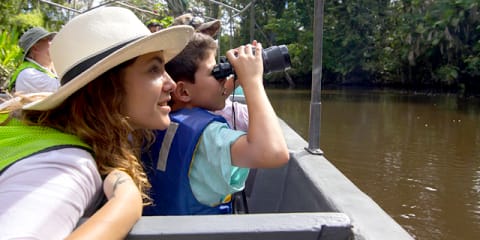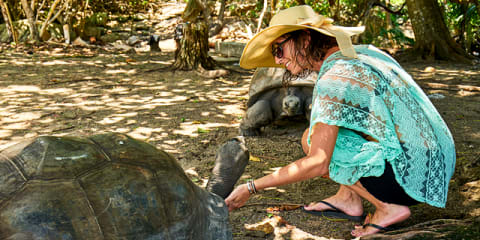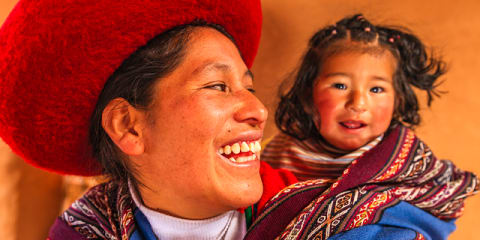The Galápagos
In no other place on earth can you find such a bizarre and fascinating biodiversity, where penguins swim with dolphins, and sea lions share the sand with iguanas. And don’t forget the giant tortoises! 600 miles off the coast of Ecuador, a hidden gem lies in wait for the adventurous traveler – the Galápagos Islands feature incredible landscapes that are just as picturesque and memorable as the wildlife. Some islands feature cloud forests and lush tropical vegetation, while others feel as though they are from an alien planet formed by volcanic activity and home to strange desert vegetation that is seemingly out of place. About half of this remote volcanic archipelago species are found nowhere else on earth. Travel in the footsteps of Charles Darwin on an island safari and experience this one-of-a-kind place for yourself!
Tours & Packages
- Destinations: The Galápagos
- including closed packages



Trip Reviews & Photos
We love hearing your stories and seeing your photos! Check out our entire fan photo gallery and upload your photos.
Highlights
- Santa Cruz Island
Known for its sandy beaches, giant tortoises, and fascinating natural wonders, Santa Cruz Island is the only Galápagos Island with six different vegetation zones full of diverse wildlife, flora, and fauna. The island is home to the charming town of Puerto Ayora, the main port of the islands that encompasses bustling streets, tasty restaurants, and a variety of recreational activities. Explore Tortuga Bay and watch sea turtles and marine iguanas gliding in the turquoise waters, or travel to the Charles Darwin Research Station to see endangered giant tortoises mingle freely with one another. Marvel at the natural wonders of Santa Cruz, including illuminated lava tunnels and Los Gemelos, two massive volcanic sinkholes.
- Tortuga Bay
Located on Santa Cruz Island lies the white-sand beaches of Tortuga Bay. A short path through a unique cactus forest home to Darwin Finches, Mockingbirds, Yellow Warblers, Lava Lizards, and other native species will lead you to the stunning beach. Tortuga Bay is surrounded by pristine waters and secluded coves that are perfect for snorkeling and discovering the marine creatures that call this bay home, including stingrays and baby reef sharks. Search for wildlife among the volcanic rocks and see the vibrant-colored Galápagos crabs and many marine iguanas, the only lizard species in the world that can swim!
- Los Gemelos
Prepare to be amazed by the sight of these spectacular natural wonders -- Los Gemelos. Located in the highlands of Santa Cruz Island and often referred to as "The Twins," these magnificent volcanic sinkholes were formed by the collapse of the land beneath them and are genuinely an awe-inspiring visual reminder of the power of nature. Standing atop the opening and peering down into the gaping crater covered in lush greenery and seemingly endless forests, these giant craters are immensely impressive.
- Isabela Island
The largest island of the Galápagos (almost 4x the size of Santa Cruz Island!) and one of the most volcanically active places in the world, Isabela Island was formed over 1 million years ago by merging six volcanoes, most of which are still active to this day. The island was named after Queen Isabella of Spain, although it was initially named "Albemarle" in honor of the Duke of Albemarle. Although parts of the island contain sprawling lava fields and minimal vegetation, there are also areas where lush vegetation thrives. The waters of Isabela Island are the best to spot whales, including humpbacks, orcas, and more!
- Blue-footed boobies
When you travel to the Galapagos Islands, you'll be able to distinguish these romantic fellas from the rest! Blue-footed boobies are one of three booby species found on the Galapagos Islands. These large, unique birds are found nesting in rocky areas on small islands. You'll easily spot the blue-footed boobies strutting around with exaggerated movements, showing off their fabulously vibrant blue feet. The beautiful hue of their feet plays a considerable role when courting a female booby -- the bluer the feet, the more attractive the mate! You'll get to experience the entertaining sight of these incredible creatures trying to impress all the single ladies by performing elaborate mating dances. Their name derives from the Spanish word 'bobo,' meaning foolish – which accurately describes their uncoordinated movements on land!
- Prickly Pear Cactus Forest
In the arid inland areas of the Galapagos Islands lives such extraordinary greenery; you have to see it to believe it! These unique and distinctive cacti, covered in paddle-shaped leaves, are known as Prickly Pear Cacti. With 200 species of prickly pear that grow across the Americas, only six thrive in the Galapagos Islands. You'll notice some cacti are shorter or taller than others, which signifies that hungry giant tortoises are in the area. This is because the tall cacti thrive in regions where giant tortoises settle, whereas shorter cacti fall victim to tortoises munching on the lush green leaves for their meals. The cacti are consumed by land iguanas, doves, cactus finches, and mockingbirds.
Fast Facts
Already booked on one of our packages to the Galápagos? See everything you need to know before you go.
| Overview | Capital: Puerto Baquverizo Moreno (Mainland, Ecuador – Quito) |
| Entry requirements | Please see our Entry Requirements page. |
| Staying Healthy | Malaria Malaria is present in Ecuador. Take precautions against getting mosquito bites. Speak with your doctor about taking a prescription medicine (before, during and after your trip) to prevent malaria. CDC Malaria guidance: Galapagos Islands Yellow Fever The CDC recommends Yellow Fever vaccine for all travelers who will visit Yellow Fever Endemic areas of Ecudaor. Ask your physician for more information. CDC Guidance by country: Galápagos Islands Proof of Yellow Fever Vaccination is required for travelers arriving to Ecuador (including the Galápagos Islands) from Brazil, Democratic Republic of the Congo, or Uganda. This includes airport transits or layovers of more than 12 hours. |
| Weather | Ecuador is located at the Equator, but the temperatures vary little throughout the year. The average high temperature during the day is around 70°F and the average low temperature at night is around 50°F. There are two seasons, wet and dry. The wet season lasts from December through May, with varying amounts of rain during this time. The dry season lasts from the end of May to December, when little rain is expected to fall. In the Galápagos, the temperatures are similar to Quito, with the wet season lasting from December through May and the dry season lasting from June through December. The wet season is warmer and more tropical than the dry season, with temperatures ranging from the 70’s to the 90’sbut the ocean temperature is warmer, too. |
| What to wear | For travel in the Galápagos, clothing ranges from informal to very informal. Essentials include sneakers, shorts, long- and short-sleeve lightweight shirts, bathing suit, a wide-brimmed hat, long pants, and a wind breaker or light jacket for evenings. Be sure to bring sunscreen, sunglasses and lots of film. Most walking ashore is over rocky lava terrain. Tennis shoes, sneakers, or walking shoes with rubber soles are strongly recommended. |
| Money & Credit Cards | The official currency in Ecuador is the US Dollar. Hotels and some stores accept credit cards (Visa and Master Card mostly, but AMEX is accepted in some establishments). For “street shopping” you will need cash for most transactions. We highly recommend that you bring along crisp, new bills and smaller denominations. Stick with $1, $5. $10 and $20 notes. Old, torn, crumpled bills may not be accepted. Be sure to call your credit card providers to let them know you will be traveling abroad, the places you’ll be visiting, and the dates of your trip. This is important for your own protection. For small purchases, we recommend that you use the ATM machines to get cash to avoid using your credit card in unknown shops where there is a higher risk of having your credit card numbers “borrowed” for unauthorized purchases. Traveler’s checks are no longer accepted in Ecuador. Expect to use cash or credit cards for all your purchases. Always notify your bank prior to departure to avoid any problems using your credit or debit card while traveling. |
| Shopping | Shopping is limited in the Galápagos Islands. The best place to purchase the quintessential “Galápagos Island” souvenir gear is at the Charles Darwin Research Station which offers high quality items and proceeds benefit the preservation efforts. |
| Electricity & Power Adapters | 110 volts. We recommend that you bring an adapter/converter along with you as not all hotels will have 110 volt (A&B plugs) outlets. Learn more about electrical standards around the world. |
| Cell Phones & Internet | Want to take your cell phone, tablet or laptop, but not sure how to get cell service or wifi? Read up on using your cell phone abroad and the top 5 ways to get Internet abroad. |
| Did you know? |
|
Frequently Asked Questions
What are the Dos and Don’ts of Environmentally friendly travel to the Galapagos Islands?
Do:
Listen to your guide for your safety and the safety of the wildlife
Pack plenty of extra space on your camera card! You’ll want to take a LOT of photos!
Keep on the designated paths as you explore the islands
Drink plenty of water along the way
Consider the clothing and footwear you will use on the trip – there is a lot of walking on sometimes uneven terrain in the Galapagos Islands
Always dispose of litter in the appropriate receptaclesDon’t:
Take food or plants to the islands. This might jeopardize the ecosystem.
Feed or touch the animals – no matter how friendly they seem!
Skip the detailed information provided by your guide – their expertise will enrich your experience!
Take “souvenirs” of rocks, plants, or other natural material.
As a note, smoking is prohibited in the national park areas.- Is snorkeling gear included?
Snorkeling gear is included on our tours.


 Known for its sandy beaches, giant tortoises, and fascinating natural wonders, Santa Cruz Island is the only Galápagos Island with six different vegetation zones full of diverse wildlife, flora, and fauna. The island is home to the charming town of Puerto Ayora, the main port of the islands that encompasses bustling streets, tasty restaurants, and a variety of recreational activities. Explore Tortuga Bay and watch sea turtles and marine iguanas gliding in the turquoise waters, or travel to the Charles Darwin Research Station to see endangered giant tortoises mingle freely with one another. Marvel at the natural wonders of Santa Cruz, including illuminated lava tunnels and Los Gemelos, two massive volcanic sinkholes.
Known for its sandy beaches, giant tortoises, and fascinating natural wonders, Santa Cruz Island is the only Galápagos Island with six different vegetation zones full of diverse wildlife, flora, and fauna. The island is home to the charming town of Puerto Ayora, the main port of the islands that encompasses bustling streets, tasty restaurants, and a variety of recreational activities. Explore Tortuga Bay and watch sea turtles and marine iguanas gliding in the turquoise waters, or travel to the Charles Darwin Research Station to see endangered giant tortoises mingle freely with one another. Marvel at the natural wonders of Santa Cruz, including illuminated lava tunnels and Los Gemelos, two massive volcanic sinkholes. Located on Santa Cruz Island lies the white-sand beaches of Tortuga Bay. A short path through a unique cactus forest home to Darwin Finches, Mockingbirds, Yellow Warblers, Lava Lizards, and other native species will lead you to the stunning beach. Tortuga Bay is surrounded by pristine waters and secluded coves that are perfect for snorkeling and discovering the marine creatures that call this bay home, including stingrays and baby reef sharks. Search for wildlife among the volcanic rocks and see the vibrant-colored Galápagos crabs and many marine iguanas, the only lizard species in the world that can swim!
Located on Santa Cruz Island lies the white-sand beaches of Tortuga Bay. A short path through a unique cactus forest home to Darwin Finches, Mockingbirds, Yellow Warblers, Lava Lizards, and other native species will lead you to the stunning beach. Tortuga Bay is surrounded by pristine waters and secluded coves that are perfect for snorkeling and discovering the marine creatures that call this bay home, including stingrays and baby reef sharks. Search for wildlife among the volcanic rocks and see the vibrant-colored Galápagos crabs and many marine iguanas, the only lizard species in the world that can swim! Prepare to be amazed by the sight of these spectacular natural wonders -- Los Gemelos. Located in the highlands of Santa Cruz Island and often referred to as "The Twins," these magnificent volcanic sinkholes were formed by the collapse of the land beneath them and are genuinely an awe-inspiring visual reminder of the power of nature. Standing atop the opening and peering down into the gaping crater covered in lush greenery and seemingly endless forests, these giant craters are immensely impressive.
Prepare to be amazed by the sight of these spectacular natural wonders -- Los Gemelos. Located in the highlands of Santa Cruz Island and often referred to as "The Twins," these magnificent volcanic sinkholes were formed by the collapse of the land beneath them and are genuinely an awe-inspiring visual reminder of the power of nature. Standing atop the opening and peering down into the gaping crater covered in lush greenery and seemingly endless forests, these giant craters are immensely impressive. The largest island of the Galápagos (almost 4x the size of Santa Cruz Island!) and one of the most volcanically active places in the world, Isabela Island was formed over 1 million years ago by merging six volcanoes, most of which are still active to this day. The island was named after Queen Isabella of Spain, although it was initially named "Albemarle" in honor of the Duke of Albemarle. Although parts of the island contain sprawling lava fields and minimal vegetation, there are also areas where lush vegetation thrives. The waters of Isabela Island are the best to spot whales, including humpbacks, orcas, and more!
The largest island of the Galápagos (almost 4x the size of Santa Cruz Island!) and one of the most volcanically active places in the world, Isabela Island was formed over 1 million years ago by merging six volcanoes, most of which are still active to this day. The island was named after Queen Isabella of Spain, although it was initially named "Albemarle" in honor of the Duke of Albemarle. Although parts of the island contain sprawling lava fields and minimal vegetation, there are also areas where lush vegetation thrives. The waters of Isabela Island are the best to spot whales, including humpbacks, orcas, and more! When you travel to the Galapagos Islands, you'll be able to distinguish these romantic fellas from the rest! Blue-footed boobies are one of three booby species found on the Galapagos Islands. These large, unique birds are found nesting in rocky areas on small islands. You'll easily spot the blue-footed boobies strutting around with exaggerated movements, showing off their fabulously vibrant blue feet. The beautiful hue of their feet plays a considerable role when courting a female booby -- the bluer the feet, the more attractive the mate! You'll get to experience the entertaining sight of these incredible creatures trying to impress all the single ladies by performing elaborate mating dances. Their name derives from the Spanish word 'bobo,' meaning foolish – which accurately describes their uncoordinated movements on land!
When you travel to the Galapagos Islands, you'll be able to distinguish these romantic fellas from the rest! Blue-footed boobies are one of three booby species found on the Galapagos Islands. These large, unique birds are found nesting in rocky areas on small islands. You'll easily spot the blue-footed boobies strutting around with exaggerated movements, showing off their fabulously vibrant blue feet. The beautiful hue of their feet plays a considerable role when courting a female booby -- the bluer the feet, the more attractive the mate! You'll get to experience the entertaining sight of these incredible creatures trying to impress all the single ladies by performing elaborate mating dances. Their name derives from the Spanish word 'bobo,' meaning foolish – which accurately describes their uncoordinated movements on land! In the arid inland areas of the Galapagos Islands lives such extraordinary greenery; you have to see it to believe it! These unique and distinctive cacti, covered in paddle-shaped leaves, are known as Prickly Pear Cacti. With 200 species of prickly pear that grow across the Americas, only six thrive in the Galapagos Islands. You'll notice some cacti are shorter or taller than others, which signifies that hungry giant tortoises are in the area. This is because the tall cacti thrive in regions where giant tortoises settle, whereas shorter cacti fall victim to tortoises munching on the lush green leaves for their meals. The cacti are consumed by land iguanas, doves, cactus finches, and mockingbirds.
In the arid inland areas of the Galapagos Islands lives such extraordinary greenery; you have to see it to believe it! These unique and distinctive cacti, covered in paddle-shaped leaves, are known as Prickly Pear Cacti. With 200 species of prickly pear that grow across the Americas, only six thrive in the Galapagos Islands. You'll notice some cacti are shorter or taller than others, which signifies that hungry giant tortoises are in the area. This is because the tall cacti thrive in regions where giant tortoises settle, whereas shorter cacti fall victim to tortoises munching on the lush green leaves for their meals. The cacti are consumed by land iguanas, doves, cactus finches, and mockingbirds.